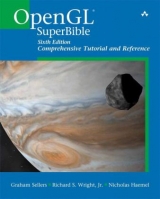
OpenGL SuperBible
Addison-Wesley Educational Publishers Inc (Verlag)
978-0-321-71261-5 (ISBN)
- Titel erscheint in neuer Auflage
- Artikel merken
Coverage includes
• A practical introduction to the essentials of real-time 3D graphics
• Core OpenGL 3.3 techniques for rendering, transformations, and texturing
• Writing your own shaders, with examples to get you started
• Cross-platform OpenGL: Windows (including Windows 7), Mac OS X, GNU/Linux, UNIX, and embedded systems
• OpenGL programming for iPhone, iPod touch, and iPad: step-by-step guidance and complete example programs
• Advanced buffer techniques, including full-definition rendering with floating point buffers and textures
• Fragment operations: controlling the end of the graphics pipeline
• Advanced shader usage and geometry management
• A fully updated API reference, now based on the official ARB (Core) OpenGL 3.3 manual pages
• New bonus materials and sample code on a companion Web site, www.starstonesoftware.com/OpenGL
Part of the OpenGL Technical Library–The official knowledge resource for OpenGL developers
The OpenGL Technical Library provides tutorial and reference books for OpenGL. The Library enables programmers to gain a practical understanding of OpenGL and shows them how to unlock its full potential. Originally developed by SGI, the Library continues to evolve under the auspices of the OpenGL Architecture Review Board (ARB) Steering Group (now part of the Khronos Group), an industry consortium responsible for guiding the evolution of OpenGL and related technologies.
Richard S. Wright, Jr., is a Senior Software Engineer for Software Bisque, where he develops multimedia astronomy and planetarium software using OpenGL. A former Real 3D representative to the OpenGL ARB, he has written many OpenGL-based games, scientific and medical applications, database visualization tools, and educational programs. Nicholas Haemel has led 3D graphics hardware/software architecture design and development for eight years at ATI and AMD, and contributed to OpenGL standards 3.0, 3.1, 3.2, and 3.3. Graham Sellers is a manager in the OpenGL group at AMD and leads a team of OpenGL software developers working on AMD’s OpenGL drivers. He represents AMD at the ARB, has authored many OpenGL extensions, and contributed to the OpenGL 3.2, 3.3, and 4.0 specifications. Benjamin Lipchak, Software Engineering Manager at Apple, leads a team working on graphics developer technologies and benchmarks, and is responsible for OpenGL ES conformance of iPhone and iPod touch. He formerly managed an OpenGL ES driver team at AMD and led the Khronos OpenGL ecosystem group, where he established the OpenGL SDK and OpenGL Pipeline newsletter.
Preface to the Fifth Edition xxi
Preface to the Fourth Edition xxiii
Preface to the Third Edition xxvi
Introduction 1
PART I Basic Concepts 7
1 Introduction to 3D Graphics and OpenGL 9
2 Getting Started 33
3 Basic Rendering 79
4 Basic Transformations: A Vector/Matrix Primer 125
5 Basic Texturing 179
6 Thinking Outside the Box: Nonstock Shaders 229
7 More Advanced Texture Topics 289
PART II Intermediate to Advanced Ideas 321
8 Buffer Objects: Storage Is Now in Your Hands 323
9 Advanced Buffers: Beyond the Basics 359
10 Fragment Operations: The End of the Pipeline 391
11 Advanced Shader Usage 411
12 Advanced Geometry Management 471
PART III Platform-Specific Notes 539
13 OpenGL on Windows 541
14 OpenGL on OS X 569
15 OpenGL on Linux 597
16 OpenGL ES on Mobile Devices 619
Appendix A Further Reading 653
Appendix B Glossary 655
Appendix C OpenGL Man Pages for (Core) OpenGL 3.3 661
Index 939
| Verlagsort | New Jersey |
|---|---|
| Sprache | englisch |
| Maße | 189 x 229 mm |
| Gewicht | 1620 g |
| Themenwelt | Informatik ► Grafik / Design ► Digitale Bildverarbeitung |
| Informatik ► Grafik / Design ► Film- / Video-Bearbeitung | |
| Schlagworte | OpenGL |
| ISBN-10 | 0-321-71261-7 / 0321712617 |
| ISBN-13 | 978-0-321-71261-5 / 9780321712615 |
| Zustand | Neuware |
| Informationen gemäß Produktsicherheitsverordnung (GPSR) | |
| Haben Sie eine Frage zum Produkt? |
aus dem Bereich



